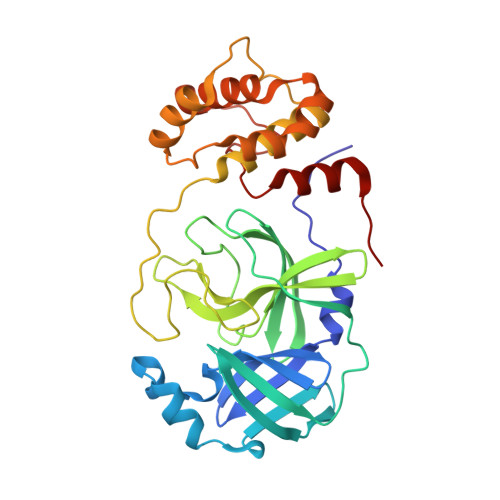Strategy to overcome a nirmatrelvir resistance mechanism in the SARS-CoV-2 nsp5 protease.
Neilsen, G., Lan, S., Slack, R.L., Lorson, Z.C., Emanuelli Castaner, A., Lee, R., Edwards, K.G., Zhang, H., Lee, J., Cantara, W.A., Cilento, M.E., Zhang, H., De, R., Amblard, F., Tedbury, P.R., Kirby, K.A., Schinazi, R.F., Sarafianos, S.G.(2025) Sci Adv 11: eadv8875-eadv8875
- PubMed: 40479048
- DOI: https://doi.org/10.1126/sciadv.adv8875
- Primary Citation of Related Structures:
9EEI, 9EET, 9EEV - PubMed Abstract:
E166V in the severe acute respiratory syndrome coronavirus 2 (SARS-CoV-2) nsp5 protease confers strong resistance to the antiviral component of Paxlovid, nirmatrelvir (NIR), in passaging and clinical samples. In SARS-CoV-2 replicons, E166V drastically decreased Washington (WA1) but not Omicron (BA.1) fitness (20- versus 2-fold), suggesting a lower barrier to resistance in the BA.1 strain and consistent with observed differences in respective nsp5 dimerization affinities. Crystal structures reveal a steric clash between the rigid, bulky NIR tert -butyl group and the ¦Â-branched Val 166 , disrupting the covalent binding of NIR to the catalytic Cys 145 and leading to high resistance in BA.1 and WA1 replicons. NIR-resistant replicons remained susceptible to GC376, which can still covalently bind Cys 145 by avoiding a steric clash with Val 166 through "wiggling and jiggling." Hence, strategic flexibility is a strategy that will help design second-generation antivirals against NIR-resistant viruses.
Organizational Affiliation:
Center for ViroScience and Cure, Laboratory of Biochemical Pharmacology, Department of Pediatrics, Emory University School of Medicine, Atlanta, GA 30322, USA.

















